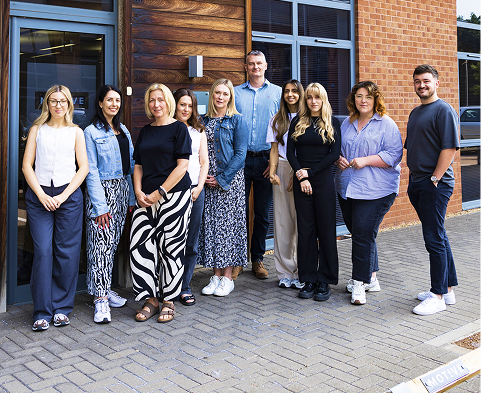It’s a cliché you’ve likely heard countless times, but it remains true – the digital PR industry really is always shifting and adapting to new trends and technologies, and keeping up with those changes is essential for running successful campaigns.
Yet while some trends blow up then fade quickly (‘dream job’ and ‘AI predicts’ campaigns – I’m looking at you!), certain campaign formats continue to deliver strong results year after year.
With search algorithms evolving, journalist priorities shifting, and new media formats gaining traction, digital PR is harder to nail than ever – 72% of industry professionals say it's more difficult in 2025 than in 2024.
.jpg)
This is why it’s important to establish which trends are worth your time and which tactics remain reliable, so you can continue to craft campaigns that stand out and secure valuable coverage and backlinks. Ultimately, you should always prioritise generating great ideas first, and then choose the ideal campaign format to bring that idea to life. If you focus too much on fitting an idea into a specific format, you risk shoehorning it into something that doesn’t align, or dismissing a great idea just because it doesn’t work within an index campaign format or isn’t suitable for a survey.
But knowing what does and doesn’t generally work can be the foundation for a showstopping idea, so if you’re interested to learn more about the different types of digital PR campaigns generating success in 2025, this blog is for you.
What’s in this article:
What is a digital PR tactic?
In a nutshell, a digital PR tactic is a specific technique used to earn coverage and links. These tactics leverage digital tools, platforms, and content to amplify a brand’s presence and reputation online. In this blog, we look at eight popular formats: Reactive PR and newsjacking, thought leadership and expert comments, unique indexes, survey-led campaigns, other data-led campaigns, visual campaigns, and product PR/PR stunts.
However, it’s important to remember there is no rulebook when it comes to digital PR tactics. It really depends on the budget and resources you have available, and the ideas you can come up with. But, there are certain tactics or campaign formats that are used time and time again – for good reason.
Each of these tactics can be tailored to specific PR goals, and when executed well, they help to build a strong online presence and improve the overall digital reputation of a brand or organisation.
What digital PR tactics are performing well in 2025?
Reactive PR and newsjacking
The goal of any PR campaign is to raise awareness of your brand, position it as a trusted authority in your industry, and leverage the results to enhance your online presence. One of the most effective ways to achieve this is by consistently inserting your brand into relevant and trending news topics.
Journalists are always on the lookout for expert commentary and insights to strengthen their stories, and this presents an excellent opportunity for brands to swoop in to help them out. The only downside to newsjacking is that you have to act fast in order to get in there before any of your competitors – and that often means having a nominated spokesperson on hand to help answer or at least approve comments before they go over to the journalist. When it’s done right, though, the results are often fruitful.
Thought leadership and expert comments
This PR tactic is tried and tested, and it consistently delivers measurable results. In fact, thought leadership content and expert comments form the foundation of the majority of the PR strategies we develop for our clients, and this is because nearly half of journalists (47%) say that industry experts are the most useful for generating content.
.jpg)
No matter your industry or the products and services you offer, there will always be valuable insights you can share with both your target audience and, in many cases, the wider public. This can be done through concise 500-600 word press releases or ‘PR stories’ that we can pitch to the media on your behalf. As long as it entertains, informs, surprises, or educates, it’ll likely have PR potential.
The beauty of this approach is that it doesn’t require a huge investment of time or budget. It’s something we can quickly turn around with minimal input from a client. All we need is an understanding of the themes and topics they can discuss, along with any key insights from their sector – the stuff that we wouldn’t necessarily know about. From there, we can handle the rest and share drafts for feedback before distributing them to the press.
Here are some real life examples we have of implementing this tactic:
- As people began preparing their gardens for spring and summer, our online garden centre client shared advice on a 65p hack to get patios looking brand new (informs and educates).
- Our luxury mattress client shared seven signs that you have dust mites in your mattress (surprises and educates).
- Our dog food client alerted pet owners to the potential risks of some cleaning products to their furry friends (surprises, informs and educates). We pitched this in March, which was perfectly timed for the upcoming spring cleaning season.
Unique indexes
In our experience, index campaigns remain one of the most effective ways to secure valuable backlinks. They typically follow a familiar format when pitched to the press: ‘[X] is the best/worst [Y] for [Z].’ Chances are, you’ve come across a few, whether you work in PR or not. If you’ve ever seen a headline like ‘[Place] ranked as the best city for [X],’ that’s an index campaign, live in action!
They work by creating a brand-new dataset, combining multiple data points, and ranking them in a unique way. These campaigns typically use publicly available data, research, or surveys to generate ranked lists of places, people, brands, or trends. Presented as a league table or ‘index’ (hence the name), this format makes the information easy for journalists and audiences to digest and extract key insights from.
Many index campaigns focus on specific locations, making them particularly effective for earning links from regional media. You can rank a place as the worst for something, pitch it to the local press in that area, and watch the reactions roll in! Some of the most successful indexes centre around themes like affordability, sustainability, or quality of life – offering opportunities for both local and national outreach. Because they are data-led and often evergreen, some index campaigns can be updated annually to maintain relevance and continue earning coverage long after they first go live. This makes them a great long-term strategy for securing natural links and positioning brands as industry authorities.
One example of an incredibly successful index campaign we’ve produced is this pickpocketing index for our travel insurance client. Since we first launched the campaign in 2023, the page has earned close to 200 backlinks from high DR sites like The Telegraph, Euro News, and Reader’s Digest.
.jpg)
Another great example that we’ve produced is the Most Stressful Airport in the US index for client StressFreeCarRental. Destinations were ranked based on five stress-inducing factors (passenger numbers, distance from the city centre, number of flight destinations, car parking charges and departure delays), to reveal Chicago O’Hare International as America’s most stressful airport. U.S. and travel media ate this campaign up, landing us links on the likes of AOL, Time Out, Washington Examiner, and Business Traveler USA.
.jpg)
Survey-led campaigns
Survey-led digital PR campaigns continue to thrive in 2025 because they tap into exclusive, timely, and data-driven storytelling, which journalists and audiences love! Offering a glimpse into consumer behaviour or societal attitudes, these campaigns provide fresh, newsworthy insights that drive engaging and shareable content. After all, who doesn’t love a peek into public opinion – or should we say, a bit of nosy curiosity? It’s like pulling back the curtain to reveal what people really think or feel about different situations.
The media landscape is as saturated as ever, but journalists continue to require unique angles and fresh statistics to bolster their articles. Survey-led campaigns provide proprietary data that can’t be found elsewhere, making them highly linkable and shareable. They also allow brands to quickly respond to emerging trends, current events, and social shifts.
One of the main reasons they perform so well is because they naturally produce some of the most attention-grabbing headlines you’ll see, which increases their appeal to journalists and readers. You’ve only got to spend a few minutes browsing through your favourite news sites to stumble upon headlines that have been generated from survey statistics. Here are some examples:
.jpg)
Other data-led campaigns
Do you even “do” digital PR if you haven’t produced a campaign based on customer data, internal data, or Google Search data in the last 12 months? Probably not, as 95% say data-led content is their most popular tactic.
If you haven’t realised already, the key to a successful campaign is data, data, data. Any time you can be offering something fresh and unique that can be backed by actual insights and statistics, you should be setting yourself up for success. (Emphasis on the should here – there’s no hard and fast rule for this and you can never say a campaign will work with 100% certainty!)
Data not only drives the narrative but also lends credibility to your campaign, making it more compelling to journalists and readers as you can actually back up what you’re saying. So when you base your campaigns on data, you can create content that resonates and increases your chances of media coverage, backlinks, and social media shares. Using the right data at the right time ensures that your PR efforts are both strategic and effective, moving beyond guesswork and anecdotal information, to deliver measurable, meaningful results.
Find out more about the power of data in PR in this blog post.
Visual campaigns
These are the campaigns that use creative images, videos, infographics, and other visual content to engage audiences and promote a brand, product or service. They’re designed to capture attention quickly and make an impact through compelling and easy-to-digest visuals.
Data visualisation campaigns are a great example of this, such as good, old-fashioned infographics. These campaigns use visual elements to highlight trends, statistics, or research findings. For example, a survey-led campaign might present results through bar charts, pie graphs, or heat maps to make the data more engaging and shareable.
Maps are another effective way to visualise data and remain as popular as ever. One fantastic example of this style is the Most Common Dream in Every Country campaign by Mornings.co.uk, but you can take a look at websites like Visual Capitalist or forums like the r/MapPorn subreddit for more inspiration.
Another visual campaign format that used to consistently perform well is the ‘Reimagined’ format. These campaigns generally show the contrast between two opposing concepts or reimagine something entirely new. The rise of AI and Midjourney has made this format easier to execute, and as a result ‘Reimagined’ campaigns were up 18% in 2023 compared to 2022. While the format may have become a bit overused and stale in the past couple of years, it can still work well with the right hook or fresh angle.
Interactive campaigns
If you really want to pull out all the stops and create a sustainable digital PR campaign that will continue to build links month after month – and you have a strong idea (that’s essential!) – it could be worth investing time and resources into creating an eye-catching interactive campaign.
Instead of simply presenting information in a static format, these campaigns use interactive elements like quizzes, maps, games, calculators, or data-driven tools to make content more engaging and shareable. Here are some popular formats you might have seen:
- Quizzes: Engaging, shareable content that allows users to answer a set of questions and receive personalised results, often encouraging social sharing.
- Interactive maps: Digital maps that let users explore data, discover insights, or contribute their own information in a visual and engaging way.
- Calculators and tools: Custom built tools that help users calculate, estimate, or analyse something relevant to their interests, needs, or industry.
- Augmented reality (AR) experiences: Brands using AR filters on social media, like trying on virtual Halloween makeup or visualising how a plant will look in their home.
A great example is Kayak’s Best Time to Travel calculator. This tool allows users to enter their desired holiday destination and provides valuable data, including flight and accommodation costs, as well as expected temperatures. Travellers can use this information to determine the best time of year to visit and get the most value for their money.
Product PR/product stunts
Product PR focuses on generating media coverage and public interest by showcasing a product in a unique, newsworthy, or creative way, but product stunts take this a step further by using bold, often unexpected marketing tactics to grab attention and spark conversation. These stunts can involve limited-edition items, viral challenges, record-breaking attempts, or unusual collaborations designed to make headlines.
Journalists and media outlets love covering quirky, surprising, or controversial product launches, particularly those with a strong news hook.
One of my favourites from the past few years that perfectly encapsulates what a product PR stunt can achieve is the Celebrity Pillow Spray campaign from lingerie brand Pour Moi. Marketed as the closest fans might ever get to sleeping with their favourite celebrity, the sprays were designed to capture the supposed scents of stars like Harry Styles, Zac Efron, Margot Robbie, and Rihanna – perfectly demonstrating how a well-executed product PR stunt can generate widespread attention.
Another one that we actually produced ourselves is MyBaggage’s Fresh Bottled Air campaign. With the majority of MyBaggage customers being Brits moving abroad, we focused on home sick ex-pats and offered them bottled fresh air from each of the four UK home nations. The campaign made headlines around the world and delivered 610 media placements along with 410 backlinks! You can read more about the campaign here.
.jpg)
Key takeaways
- Certain digital PR tactics remain consistently effective. While some trends come and go, tried-and-tested formats like reactive PR, thought leadership, survey-led campaigns, and index campaigns continue to secure coverage and valuable backlinks.
- Choosing the right format starts with a great idea. Rather than forcing an idea into a specific format, focus on developing strong concepts and headlines first, then work backwards and determine the best execution method to maximise engagement and coverage.
- Journalist needs should shape your approach. Understanding what journalists are looking for – whether it’s expert commentary, unique data, or engaging visuals – will help you create campaigns that land coverage.
- Flexibility is key to PR success. There’s no single ‘right’ way to run a campaign – being adaptable with formats, data sources, and outreach strategies will help you stay ahead in a changing industry.
Curious about the best PR tactics for your brand? Get in touch for a consultation with our senior team.



.jpg)

.jpg)
.jpg)
.jpg)



